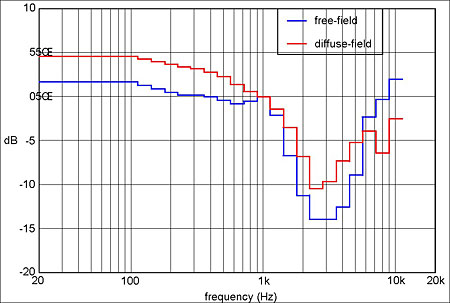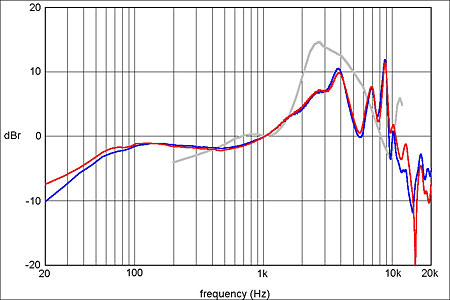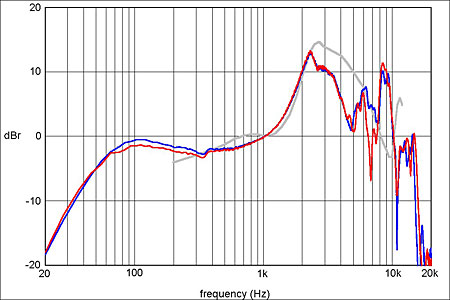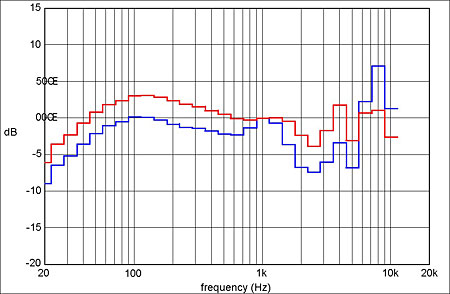| Columns Retired Columns & Blogs |
Between the Ears: the art and science of measuring headphones Page 3
The argument is made clearer by fig.3, which paraphrases the Gestalt perception model proposed by Theile. It shows how, in passing through the outer ear, sound is subject to HRTF spectral modification, H(s). This spectral modification is used by the brain to help determine the sound source's location, and then inverse filtering, H'(s), is applied to prevent the timbre of the sound from being distorted. If H'(s) is not the inverse of H(s), as Theile argued is the case with free-field headphone response because the image is not perceived as being forward of the listener, then cancellation is imperfect and, as a result, the perceived sound is colored.
Footnote 5: D. Hammershøi and H. Møller, "Determination of Noise Emission from Sound Sources Close to the Ears," Acta Acustica, Vol.94 No.1 (January 2008).

Fig.3 Gestalt hearing model used by Theile to argue against the use of free-field headphone response.
Theile contended that, because the headphone image has no preferred direction, the ideal headphone frequency response would be that which pertains at the ear in a diffuse soundfield, where sound arrives equally from all directions. This diffuse-field, or DF, response is significantly different from the FF response, and Theile went on to demonstrate its superiority in experiments in which headphones were electronically equalized to have either FF or DF responses.
If you suppose that, as a result of Theile's work, there is now a headphone-industry consensus that the DF response assumption is the correct one, prepare yourself for disappointment. Headphones continue to espouse widely differing response philosophies: some close to FF, some close to DF, and others nearer to flat. Which is "right" remains a bone of contention.
From the point of view of those who measure headphones, then, there is no hope of being able to apply a universally accepted correction to generate a "flat is correct" response. The best we can do is apply both FF and DF corrections and hope to learn by experience which, if either, truly correlates with the best subjective performance. Until recently, such corrections were not generally available for artificial ears with eardrum simulators, but recent work by Hammershøi and Møller has plugged that gap (footnote 5). Their third-octave corrections, normalized to 0dB at 1kHz, are shown in fig.4.

Fig.4 Third-octave free-field and diffuse-field corrections for artificial ears with eardrum simulators, after Hammershøi and Møller.
Let's apply these corrections to some headphone measurements and see what falls out. Fig.5 shows uncorrected frequency responses, measured using my artificial ear setup, for four midpriced headphones I tested last fall as part of a group review for Hi-Fi News: the AKG K530, Audio-Technica ATH-AD700, Beyerdynamic DT440, and Grado SR80. The blue trace is the left capsule response, the red trace the right capsule response; grayed-out in the background of each graph is the Shaw 30° free-field response as a point of reference. As you can see, the responses of these four 'phones differ quite significantly, the obvious oddball being the Audio-Technica—which was also my clear favorite in the subjective testing.




Fig.5 Uncorrected left (blue trace) and right (red) capsule responses for four midprice headphones: (a) AKG K530, (b) Audio-Technica ATH-AD700, (c) Beyerdynamic DT440, and (d) Grado SR80.
Fig.6 shows the result of converting one channel's response to third-octave form and applying Hammershøi and Møller's FF and DF corrections (red and blue traces, respectively). If we assume that the DF-corrected response is the more relevant, as Theile suggests, then the flattest results are recorded by the Beyer and Grado, the biggest difference between them occurring around 2kHz, where the Grado apparently tries to follow the Shaw FF curve and the Beyer does not. Separate nearfield measurements of each model's diaphragm behavior off the artificial ear showed the Grado's cumulative spectral-decay waterfall to have a large resonant ridge at this frequency, which perhaps explains why, in the listening tests, I found the SR80's tonal balance much too forward in the upper mids. Without so marked a response peak—and with a very clean waterfall plot— the Beyer was preferred.




Fig.6 Free-field (red trace) and diffuse field (blue) corrections applied to the responses of fig.5.
But my clear favorite overall, by a large margin, was the Audio-Technica. Its more laid-back tonal balance was much more like what I'm used to hearing from speakers, and its imaging was remarkably spacious, to an extent that I had never heard from headphones before. Already, then, I am beginning to suspect that a response somewhere between DF and flat is actually optimal. But these are early days; as other headphones pass through my lab, it will become clearer whether this is indeed the case.
Pitfalls
Aside from the philosophical issues of the ideal headphone response, there are also practical issues to be borne in mind during the measurement process. The first of these relates to the common use of significant output resistance in headphone amplifiers and the effect this has on frequency response.
Although it doesn't always appear in the specifications of headphone amps, output resistance has a nontrivial effect on frequency response, and hence on tonal balance. Many headphone amps have output resistances in the range of 20–50 ohms, the principal justification being that this helps even out the substantial differences in sensitivity between different headphones. Output from low-impedance/high-sensitivity models is attenuated more than that of high-impedance/low-sensitivity types, making it less likely that users will inadvertently expose themselves to potentially damaging sound-pressure levels. Insertion of a resistor in series with the amplifier output also helps the designer ensure short-circuit protection and unconditional feedback stability. The IEC 61938 standard goes even further in recommending an output resistance of 120 ohms, noting that "For most types of headphones, the source impedance has very little effect on the performance."
Footnote 5: D. Hammershøi and H. Møller, "Determination of Noise Emission from Sound Sources Close to the Ears," Acta Acustica, Vol.94 No.1 (January 2008).
- Log in or register to post comments




































